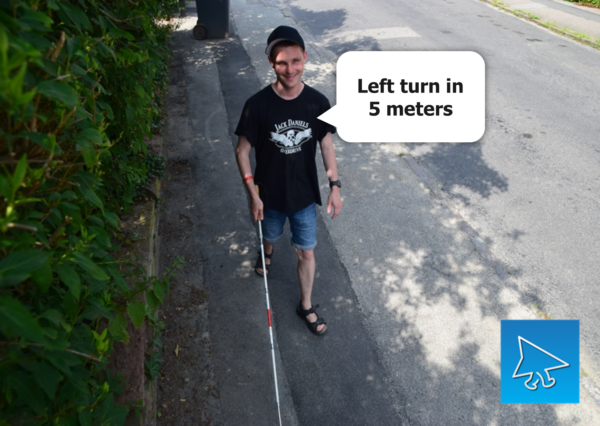Accuracy in seconds, affordability, compact size, and low power consumption enables precise navigation via a GNSS device over the NaviBlind app.
Thalwil, Switzerland – October, 28, 2021 – u-blox (SIX:UBXN), a global provider of leading positioning and wireless communication technologies and services, today announced that NaviBlind, a technology provider delivering independent, safe, and flexible navigation to blind and visually impaired users has integrated the u-blox ZED-F9P high precision module into their GNSS solution paired to the NaviBlind app.
Even with today’s smartphones, blind and visually impaired people still depend on others to learn how to walk to new places. And even with professional assistance, most blind and visually impaired people can typically only walk to five places on their own. Moreover, the conventional way of learning how to navigate a route as a blind or visually impaired person requires many hours of one-on-one training with a mobility instructor and extensive planning. With the World Health Organisation (WHO) estimating that approximately 285 million people around the world are living with blindness or visual impairment – it would be extremely cost-intensive to provide this type of training to everyone with low vision.
NaviBlind, founded in 2019, empowers blind or visually impaired users to walk to new destinations independently without prior instructions. An app paired with a GPS device delivers navigation messages with better than one-meter accuracy.
In 2018, after testing numerous GPS solutions, none of which had the accuracy required, or were too bulky and unaffordable, the NaviBlind team discovered the newly released u-blox ZED-F9P high precision global navigation satellite system module.
The u-blox ZED-F9P was the first mass market multi-band receiver to concurrently use GNSS signals from all four GNSS constellations (GPS, GLONASS, Galileo, and BeiDou) with integrated multi-band real time kinematic (RTK) technology to achieve centimeter-level accuracy in seconds – even in challenging environments such as in cities. The u-blox ZED-F9P is also cost-efficient, compact, and has low power consumption, precisely what the NaviBlind business model needed.
The NaviBlind GPS device leverages the u-blox ZED-F9P, which connects to the NaviBlind app via Bluetooth to deliver the essential positioning quality required for allowing blind and visually impaired people to access the outdoor world independently via precise voice navigation. The app also helps the user stay within the bounds of sidewalks and pedestrian crossings to avoid potential danger – such as walking onto car lanes. These features require a very accurate location service that smartphones’ internal location systems can’t possibly deliver. A regular smartphone can produce significant position errors, sometimes more than ten meters.
“I clearly remember the first time I tested the u-blox ZED-F9P with the NaviBlind app. I had this yes feeling that we’d finally found a precise enough GPS to realize our business idea,” said Jonathan Sonne Andersen, co-founder and CEO NaviBlind. “The u-blox F9 technology aligns perfectly with our business model based on innovating how blind and visually impaired people can remain safe and independent while walking wherever they choose.”
NaviBlind estimates approximately 25 million people worldwide would benefit from using the service now rolling out in Denmark and later across Europe in 2022. By working initially with municipalities and healthcare organizations in Denmark, NaviBlind intends to start empowering blind and visually impaired people so that they can remain safe and independent while walking.



















